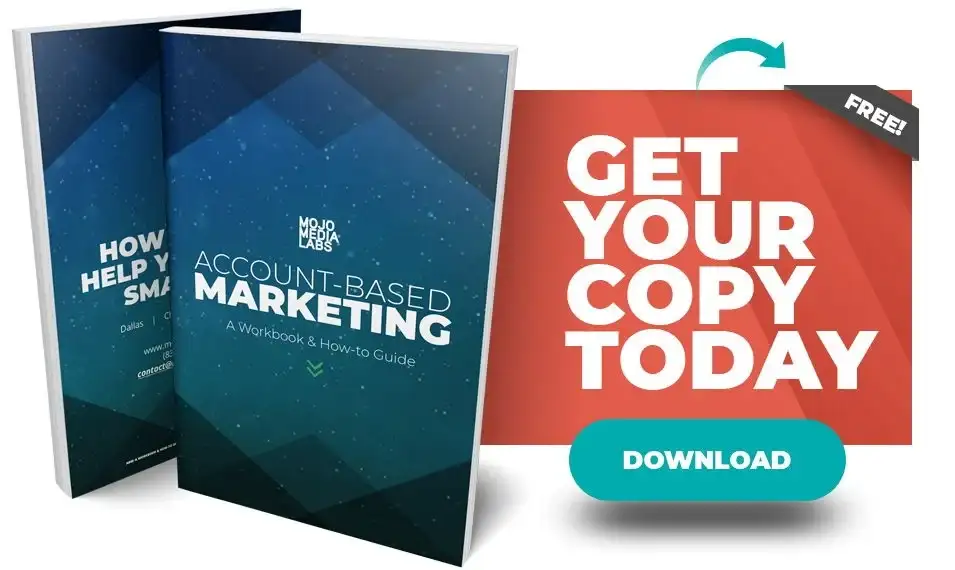10 ABM Best Practices for 2022
If you are currently building toward an ABM strategy in your organization, getting all the pieces in place can seem overwhelming. It doesn't have to be.
To ensure you have best-in-class ABM, a panel of ABM experts to break down some of their best practices to help you avoid some of the common pitfalls of implementing ABM.
1. Use Data to Drive Decisions About High-Value Accounts
You can use data to identify your high-value accounts for your ABM programs, which ultimately are just accounts that will land you bigger deals. This isn't your TAM (target addressable market) or any account you can sell into. It's a little deeper than that, so it becomes an ICP (ideal customer profile). It's a must-have in ABM. It narrows that TAM down to a target market so you can more effectively close.
Developing your ICP is a little bit of an art and a science, so you'll not only be pulling things like your closed-won opportunity reports or any sales and marketing reports. That's the science, but you'll also be conducting interviews with customer success, sales, and product marketing to understand those nuances that might not be available when you look at the data. That's the art.
2. Identify Your Target Accounts
When you are looking at selecting your target account list for your ABM program, whatever your program is intended to do, your approach, while kind of similar at the core, will be slightly different. Depending on whether you are running an acquisition, cross-sell, or upsell campaign.
You will have different strategies that you are deploying into ABM, influencing how you select your particular target accounts for your ABM program. At the baseline, we think about art or science as quantitative or qualitative data.
Revenue, industry, or employee size can all be influenced by the ultimate goal of your ABM campaign. Once you've started with the demographics, then you start layering on additional data points to help you select your target account.
- How are they currently engaging with customers?
- Do we have opportunities in the pipeline that maybe we're trying to accelerate?
- Are they showing intent?
- Either on our website or with third-party tools.
- Do they currently use our products?
- And do we have users who are power users? Do you know what their usage level is at the account?
Then, once we have some of that core data, what we like to do as we review it account by account or in a more extensive excel doc is to bring your partners along for the ride. Working hand in hand with sales and even client management will be crucial.
Having information from all teams involved like:
- What is the current relationship at the account?
- Do we have a champion or a stakeholder that is currently engaged with us right now?
- Have they been susceptible to conversations in the past?
- Were they receptive to our marketing?
These are all conversations you have with the people who know the account best to build the complete picture.
While sales make the final decision because they ultimately own the relationship, marketing should show up to this conversation with the perspective that, based on what we see and based on what we've heard, these are the appropriate target accounts for this type of campaign that you are running.
Build the data together, discuss the qualitative traits, and finalize the list together. Marketing will gain a ton of credibility and trust in the eyes of your partners across the aisle.
3. Identify Key Stakeholders and Market Directly
The next part you'll want to focus on is who you will go after at these accounts and how you can reach these key stakeholders based on where they are via email, LinkedIn, or direct mail.
When starting to market to your key stakeholders, one suggestion is to look at what key personas your company targets generally and then within that who are the influencers and buyers that you both you and sales jointly should be going after at that account.
So once you have your campaign running, it's a good idea to start looking at these accounts and the key stakeholders you already have built within your CRM to identify where we see spikes and engagement within these different personas.
So maybe you see a lot of engagement at the influence level, but not necessarily the buyer level. Well, what you need to do is improve that engagement through either marketing or sales outreach to bubble up that buying committee so that everyone that would be included in the purchase of your software is involved in and aware of the message that you're trying to resonate with from sales and marketing.
So, once you have these key stakeholders identified, it's up to our outbound prospecting to see what they are engaging with, what they have downloaded, their historical data on this account, and the context you can use to personalize your outreach to these stakeholders.
It's a joint project between sales and marketing, so it's about personalization to get to those key stakeholders at the end of the day.
4. Create a Personalized Customer Journey
Your customer journey is a lot more than that, and there are many ways to personalize all the different tactics in your marketing strategy.
The ultimate goal here should be to speak their language. Go out on messaging boards, check product reviews, conduct customer interviews, and even look at sales notes in your CRM. Understanding what these accounts are talking about and how they talk is essential. So that way, when you're crafting your message to them, you're speaking in their language and improving response rates.
So a couple of different ways you can personalize.
Co-branding on your website can be effective, so if you're taking those ads, you're driving them over to somewhere on your website.
If you can personalize your pages, you can add co-branding with their logo or even drive them to a specific landing page with content for your campaign.
Not only are you going after your target accounts, but now you're looking at an entire buying committee within that in all of the different personas.
First, run a content audit to see what exactly content you have that aligns with the journey stages and those personas.
Creating this content tends to be an issue for most teams. It doesn't have to be, it can be as simple as a light change on an existing asset that you already have, or you update the title page with some copy and relevant imagery. Suppose you have more bandwidth and can have that go throughout the rest of the asset, where you're updating the copy. In that case, the imagery can even take it as far as updating the examples and the use cases relevant to your audience.
It doesn't have to be all from scratch, so not reinventing the wheel and using what you can is a pretty smart play.
5. Choose the Right Marketing Channels for Your ABM Campaign
When choosing the channels you want to use in your ABM campaign, it's crucial to take a step back on your campaign's overall goal before diving right into the channels and tactics. Outside of ABM, we've all gone there where we're focused on the tactic immediately. Still, if you start by looking at that overall strategy for the campaign, you can begin to see what you are trying to accomplish.
We have so many channels available at our fingertips, so establishing each channel's goal is fundamental. The goal of display has a very different goal than direct mail. Are you looking to just get net new prospects to your website and build pipeline? or are you working on customers and upselling? What is the channel that's going to work best for you?
Once you've identified the overall campaign goal and the purposes of these channels, you can see how these channels can hopefully fit together.
There are a lot of areas you can personalize within your different areas of focus. How can these channels then have that same cohesive message across the board so that the display message leading you to the website is similar to if they're receiving a direct mail package? And if sales are reaching out with personalized outreach, it's all ringing true to what you're trying to accomplish within your ABM campaign, and it's keeping that personalized approach.
If you are just starting, start small.
If email, direct mail, and sales outreach are all you will do, that's okay. If you can get those threes down, you'll have some good sales wins to share and get more people on board than just trying to run thin across many different channels. This also helps you with bandwidth. Many of us don't have an entire ABM team, so having the resources to refresh your channels constantly is super helpful so that things don't go stale to your target accounts.
With this strategy, you can understand how things perform and then check them bi-weekly to optimize and slowly add in more channels as you build things out.
6. Align Marketing and Sales
Sales are interested in leads, but ultimately they're interested in the pipeline.
So we need to train our teams to speak more about pipeline, qualified opportunities, and revenue rather than impressions, website visits, webinar registrations, etc.
Once you land on those, communication becomes about how the campaign is progressing. Who owns which piece of this campaign is essential.
So, clear accountability within your campaign as you select your channels is key. Maybe there's a sales enablement piece, perhaps we need to talk about the handoff once a campaign generates some interest or an event happens. It depends on the tactics you show that can influence how we communicate back and forth between sales and marketing.
The other thing important to practice is to share wins early and often, so if you're getting a key stakeholder engaged in one of your events or get a direct mail piece to land and get a key influencer in the conversation to click over to the landing page.
Share that not only with the REP who needs to know but also with the broader team to say here are the results we are driving with these types of engagements. They're different than our regular campaigns, which is why it matters to you and then, at the end of the day, be clear about who is accountable for what piece of the conversation.
And the customer is ultimately going to provide the customer journey. Then everybody is accountable when you launch the campaign to say, these are my pieces, and these are your pieces. We all work together to deliver.
7. Define Your Campaign Goals
Aligning campaign goals with corporate objectives and sales and marketing goals is one way to make sure everyone is happy with the efforts made as you advance your ABM campaigns.
We can all relate to the millions of requests coming from every corner of the business, so this helps you focus and sift through the noise and know that at the end of the day, you're tracking towards the corporate goals and on the right path. Once you know what you're trying to achieve, things become much easier to implement.
You will have short and long-term goals, especially if you have a longer sales cycle. Your long-term goals are going to be the revenue in the pipeline. The short-term goals are going to be getting new site traffic and engagement.
No matter the goal. Plan, align, and communicate.
8. Define Your Campaign Goals
It's possible to get your ABM campaigns up and running by just building a team of existing sales and marketing people from what you have available.
ABM matters for leadership, getting that buy-in from both sales and marketing and ensuring that our ABM strategy consistently aligns with our overall marketing strategy. So we're not trying to create this crazy one-off thing. We're adding to our marketing strategy to acquire new enterprise accounts and get more significant deals within our customer base.
So it's time to start moving away from the silos within our marketing department so that our ABM goals can fit in with our overall demand, content, and marketing strategy. By doing this, we're gaining critical contacts in those areas and having a key stakeholder.
Suppose you can go to the content team, your operations team, or the design team for help. In that case, you have this more or less ABM committee of people that can push these campaigns forward with all of the different internal stakeholders it takes to make an ABM campaign successful.
9. Attract and Build Relationships with High-Quality Accounts
This is where ABM stands out in its value to your organization.
Helping sales and client management build stronger relationships with that buying committee will improve your overall relationships, reputation, and revenue.
Many tactics focus on this relationship and how we create it, especially in today's day and age. We are all looking for a unique opportunity for sales and client management to build stronger relationships with the right people at the correct accounts we've spent all this time and energy investing in.
So a couple of key points or key tips are:
- Don't focus all your energy on pipeline generation, even if you have a long sale cycle that might be a short-term relationship play.
- Also, think about how we can position our sales managers to build a stronger relationship with stakeholders, executives, etc.
A unique way to do this is to get exposure to something the customer may have never had the opportunity to do. We like to position the sales and client managers as the gatekeepers, you know, the holder of these opportunities, so prioritizing their experience is key.
10. Measure and Analyze Your Results
So, after all that work of building your lists, doing your content audit, and figuring out the personalization you need to go back, it's not over.
It's always wise to let it run for a reasonable amount of time, just so that you can pull some meaningful data. Consistently check in on it, tweak it, and optimize. As you check in on it regularly, you'll start to identify trends and see what's working and what's not.
Just because something works over here on this campaign doesn't mean it's going to work out a different campaign with a different segment and audience.
So we highly recommend that you build your dashboards and scorecards in an advanced way when you're going in there every month and pulling your reports. You're spending more time with the data and less time making it pretty, and when you launch your campaign, record a baseline set of metrics so that you can refer back to that every month or every quarter, and you can show your impact over time. This will help you tell a fantastic story.
Also, tracking milestones so if you see a spike in traffic on your website, but you know that you sent out a webinar promo invite the same day, you'll be able to correlate those two events and tell another great story about the data.
Continue, and you'll have a bank of metrics to pull from instead of scrambling around at the last minute, trying to pull the data.
Some key takeaways:
- Break through the traditional status quo of some of our outreach strategies right now and strengthen your ABM strategy, whether through direct mail or other tactics.
- Having an integrated strategy, in general, was vital. Building the relationship is important because trust is there for the entire journey.
If you want to learn more about ABM, we have 20+ live sessions at ABM-A-THON On-Demand, hundreds of blogs, podcasts, and more.



